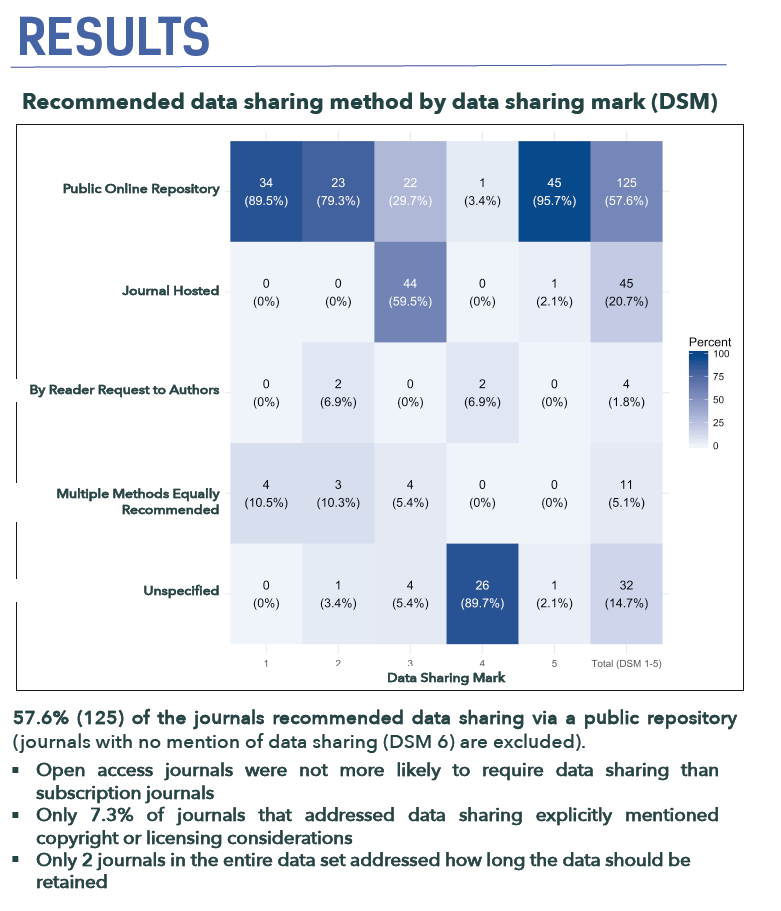We recently published Reproducible and reusable research: are journal data sharing policies meeting the mark? by Nicole Vasilevsky, Jessica Minnier, Melissa Haendel and Robin Champieux. This research looks inward to understand how the biomedical research community is sharing data and what journals are doing to encourage more transparency in science. We interviewed the authors to hear more on the current state of data sharing policies of biomedical journals and the guidelines needed to encourage wider data reuse.
PeerJ: Can you tell us a bit about yourselves?
Nicole Vasilevsky: I am a biocurator for the Ontology Development Group in the OHSU Library. My background is in cell biology and I joined our research group in the Library in 2010. I especially enjoy doing ontology development and curating biomedical data and working on projects to promote open science and scientific reproducibility.
Jessica Minnier: I am a biostatistician in the OHSU-PSU School of Public Health. I collaborate with researchers across departments and institutes and have seen many different approaches to sharing or protecting data and code. It is no small task to make these fundamental components of science open and accessible, but I believe it’s important for reproducibility and the advancement of science to make code and data available to whoever has the next great idea about how to use it. I am excited to be involved in efforts to improve and encourage open science, including this study.
Melissa Haendel: My background is in basic research with a PhD in Neuroscience, where I deeply recognized the need for improved data standardization and availability. I then became an ontologist and have spent the last 13 years developing ontologies, data standards, and policies for improving data interoperability, reuse, attribution, and open science.
Robin Champieux: I am the Scholarly Communication Librarian at OHSU, and an Open Science educator and advocate. I partner with librarians, researchers, and student communities on programming and research on issues relating to open access, data sharing, and scientific contribution. I’m especially passionate about improving science and scientific communication through community building and facilitating the success of early career researchers.
PJ: Can you briefly explain the research you published in PeerJ?
This study examines the data sharing policies for a sample of biomedical journals. Our goal was to determine if journals are requiring authors to share their data when publishing their work, and the extent to which journal data sharing policies include guidelines and requirements that facilitate reuse and reproducibility.
We found that only a minority of journals require data sharing. Moreover, while the majority of the journals in our study that require data sharing addressed the concept of reproducibility, most of these policies did not provide specific guidance on the practices that ensure data is maximally available and reusable.
PJ: What sparked your interest in data sharing? What motivated you to study journal data sharing policies?
Our team has a strong interest in the promotion and resourcing of open reproducible science. For example, previous efforts in our group have been aimed at identifying research resources and other biological entities within in the literature (see here, here and here). We consider robust data stewardship a necessary ingredient for realizing the potential benefits of open scientific workflows and communication.
This particular study was sparked when a researcher at OHSU came to Robin for help sharing a multi-terabyte imaging dataset for a Nature Neuroscience publication. Providing a quick and imperfect solution for this researcher got us thinking about journal data sharing policies, and the data management practices that make open data valuable and impactful.
PJ: Do you have any anecdotes about this research?
We presented this work at the International Society of Biocuration (ISB) Conference at Stanford University in March of 2017 and our poster [pdf] won a best poster prize. The ISB is a professional society for biocurators, who consist of biomedical researchers, data scientists and developers that aim to organize, represent and make biological data available to both humans and computers.
Additionally, this study has benefited our Open Science and data stewardship advocacy and education work at OHSU. We use it provide a studied context of the current scientific publishing landscape, and the practices researchers can and should adopt to facilitate reuse.
PJ: What kinds of lessons do you hope publishers take from the research?
We hope this study, along with related work by other teams, will spur publishers to make data sharing a requirement of publication, and to build policies that include specific data management guidelines that enable reuse, including those related to discovery, licensing, archival requirements. We would be thrilled if we repeated this study again in two years and saw an increase in the numbers of journals that are requiring data sharing.
PJ: What are your plans for taking this research further?
Our next step is to examine the data for articles published in the journals in our study set. We intend to look at the availability and quality of data (in regards to its reuse potential) and the relationship between these factors and the presence and characteristics of the journals’ data sharing policies. We’re developing a rubric that applies the FAIR-TLC principals: data should be Findable, Accessible, Interoperable, and Reusable and Traceable, Licensed, and Connected. (PMID:26978244 and Zenodo)
PJ: How did you first hear about PeerJ, and what persuaded you to submit to us?
We first learned about PeerJ when the journal launched. This is Dr. Haendel’s fourth publication with PeerJ. We have had such a positive experience publishing with PeerJ, that we were excited to publish with the journal again. We especially like the ease of submission, the preprint option, the quality of peer review, and the attention to the work post-publication. It also seems to be a journal that has a deep interest in open science and science that evaluates various aspects of science.
We especially like the ease of submission, the preprint option, the quality of peer review, and the attention to the work post-publication.
PJ: How would you describe your experience of our submission/review process?
Everything went great, the process was quick, professional and efficient. One thing we especially appreciate is there aren’t strict requirements for formatting your references–this saves a ton of time. We also like the membership model.
PJ: Would you submit again, and would you recommend that your colleagues submit?
Absolutely!
PJ: Anything else you would like to add?
In the spirit of open science and data sharing, the data we collected about journal data sharing policies is available in our github repository.
We’re in the process of creating partnerships and contributing guidelines, so the data can be built upon to provide a current and expanded source of information on journal data sharing policies.




